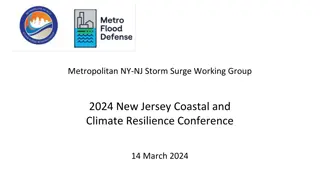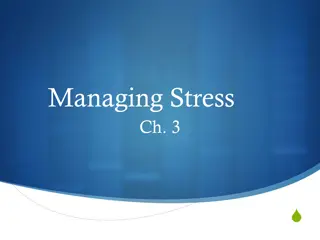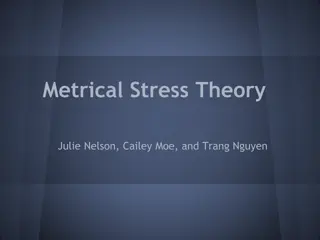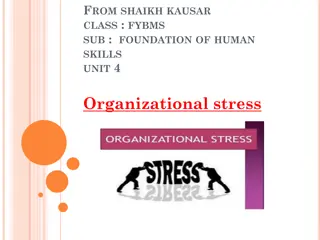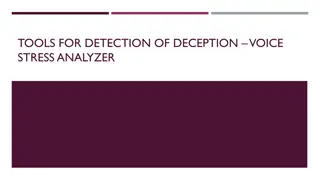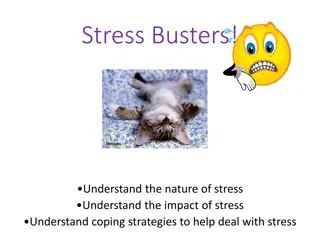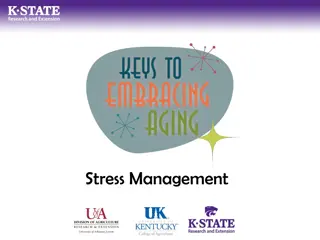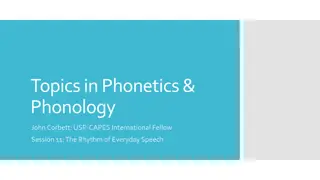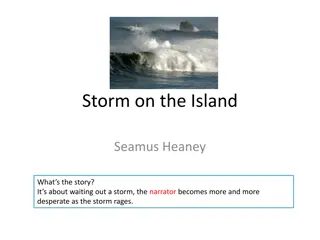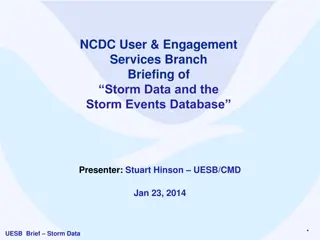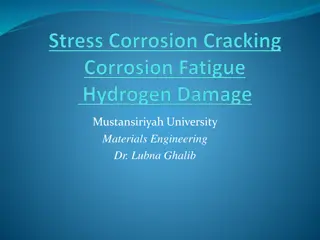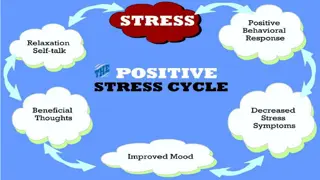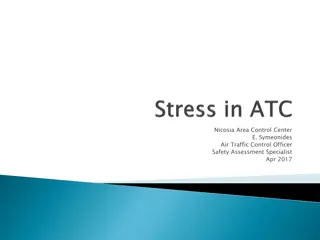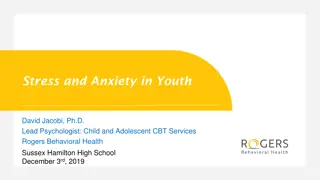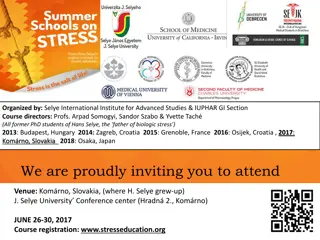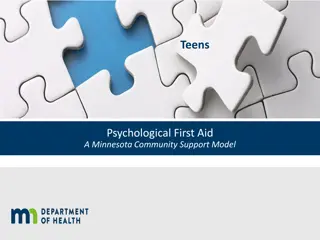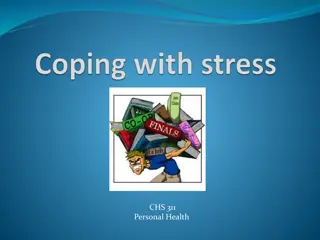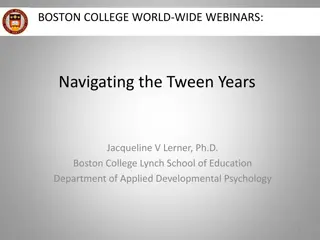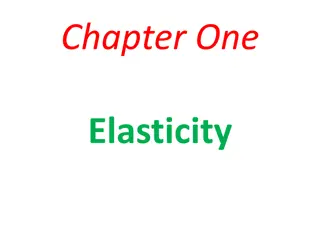Understanding Adolescence: The Storm and Stress Experience
Exploring the concept of adolescence through the lens of "storm and stress," this educational material delves into the historical perspectives and psychological aspects associated with this crucial developmental stage. From Aristotle to Rousseau, from Goethe's literary works to Hall's theories, the turbulent journey of adolescence is vividly depicted. Learners are encouraged to analyze, reflect, and comprehend the challenges and transformations faced during this phase of life.
Download Presentation

Please find below an Image/Link to download the presentation.
The content on the website is provided AS IS for your information and personal use only. It may not be sold, licensed, or shared on other websites without obtaining consent from the author. Download presentation by click this link. If you encounter any issues during the download, it is possible that the publisher has removed the file from their server.
E N D
Presentation Transcript
Welcome Md. Fazlul Karim Lecturer of English Mansur Hossain Degree College Nandigram,Bogura. 01558-682684/01713-825334
An external file that holds a picture, illustration, etc. Object name is nihms173560f1.jpg ?
The Storm and Stress of Adolescence Unit: 5 | Lesson: 1
Learners will be able to Have an idea about Adolescence Answer the question of Rearrangement Answer with clue Answer without clue Write a paragraph on Adolescence Essential information about Adolescence Learn Bangali meaning of the passage
A Brief History Hall (1904) was the first to consider the storm-and-stressissue explicitly and formally in relation to adolescent de-velopment, but he was not the first in the history of Westernthought to remark on the emotional and behavioral distinc-tiveness of adolescence. Aristotle stated that youth "areheated by Nature as drunken men by wine." Socratescharacterized youth as inclined to "contradict their parents"and "tyrannize their teachers." Rousseau relied on a stormymetaphor in describing adolescence: "As the roaring of thewaves precedes the tempest, so the murmur of rising pas-sions announces the tumultuous change.... Keep yourhand upon the helm," he advised parents, "or all is lost"(Rousseau, 1762/1962, pp. 172-173).Around the time Rousseau was writing, an influentialgenre of German literature was developing, known as"sturm und drang" literature roughly translated as "stormand stress." The quintessential work of the genre wasGoethe's (1774/1989) The Sorrows of Young Werther, astory about a young man who commits suicide in despairover his doomed love for a married woman. There werenumerous other stories at the time that depicted youthfulanguish and angst. The genre gave rise to popular use of theterm "storm and stress," which Hall (1904) adopted acentury later when writing his magnum opus on adolescentdevelopment.Hall (1904) favored the Lamarckian evolutionaryideas that were considered by many prominent thinkers inthe early 20th century (Freud and Jung included) to be abetter explanation of evolution than Darwin's theory ofnatural selection. In Lamarck's now-discredited theory,evolution takes place as a result of accumulated experience.Organisms pass on their characteristics from one genera-tion to the next not in the form of genes (which were
Main Topic with Bangla Meaning i. Children must pass through several stages in their lives to become adults. For most people, there are four or five such stages of growth where they learn certain things: infancy (birth to age 2), early childhood (3 to 8 years), later childhood (9 to 12 years) and adolescence (13 to 18 years). Persons 18 and over are considered adults in our society. Of course, there are some who will try to act older than their years. But, for the most part, most individuals have to go through these stages irrespective of their economic or social status. : ( - ), ( ), ( ) : ( ) , ,
ii. World Health Organization (WHO) identifies adolescence as the period in human growth and development that occurs after childhood and before adulthood. This phase represents one of the critical transitions in one s life span and is characterized by fast pacedd growth and change which are second only to those at infancy. Biological processes drive many aspects of this gorwth and development with the onset of puberty marking the passage from childhood to adolescence. The biological determinants of adolescence are fairly universal; however, the duration ad defining characteristics of this perion may vary across time, cultures, and socio- economic situations. This period has seen many changes over the past century-puberty for example, comes earlier than before, people marry late, and their sexual attitudes and behaviours are different from their grandparents or even parents. Among the factors responsible for the change are education, urbanization and spread of global communication. ( ) : : : : , , , - - , : , - ,
iii. The time of adolescence is a period of preparation for adulthood during which one experiences several key developments. Besides physical and sexual maturation, these experiences include movement toward social and economic independence, development of identity, the acquisition of skills needed to carry out adult relationships and roles and the capacity for abstract resoning. While adolescence is a time of tremendous growth and potential, it is also a time of considerable risks during which social contexts exert powerful influences. : : , , ,
iv. Many adolescents face pressure to use alcohol, cigarettes, or other drugs and to initiate sexual relationships putting themselves at high risk for intentional and unintentional injuries, unintended pregnancies, and sexually transmitted infections (STIs), including the himan immunodeficiency virus (HIV). Many also experience a wide range of adjustment and mental health problems. Behaviour pattrens that are established during this period such as the use or avoidance of drugs and taking or abstaining from sexual risk can have long lasting negative and positive effects on future health and well being. As a result, adults have unique opportunities to influence adolescents. , , , - /
v. Adolescents are different both from young children and adults. Specifically, adolescents are not fully capable of understanding complex concepts, or the relationship between behaviour and consequences, or the degree of control they have or can have over health decision making, including that related to sexual behaviour. This inability may make them particularly vulnerable to sexual exploitation and high-risk behaviours. Laws, customs, and practices may also affect adolescents differently than adults. For example, laws and policies often restrict adolescents access to reproductive health information and sercices, especially when they are unmarried.In addition, even when services do exist, provider attitudis about adolescents often pose a significant barrier to the use of those services. , - , , , , ,
vi. Adolescents depend on their families, their communites, schools, health services, and their workplaces to learn a wide range of skills that can help them to cope with the pressures they face and make a successful transition from childhood to adulthood. Parents, members of the community, service providers, and social institutions have the responsibility to both promote adolescent dovelopment and adjustment and to intervene effectively when probelms arise. , , , - , , -
Critical Appreciation Adolescent is a period of Storm and Stress? Adolescence is a time of storm and stress . Adolescence isa period of time between childhood and adulthood. This is the age when onecan either make something of his life or destroy it all, this is the time when a person makes those friends who changes the how he looks at life and how hefaces it. An adolescent's main goal these days is to fit in and not be differentfrom their peers. In this paper I will explore the probabilities of thefollowing grievances experienced by the adolescent youth which are drugs,suicide, and homelessness. Adolescence is the developmental stage betweenchildhood and adulthood; it generally refers to a period ranging from teenyears through 20s. As now life is growing more complex, however,adolescents are increasingly cut off from the activities of their elders,leaving most young people with education as their sole occupation.Inexorably, this has isolated many of them from the adult world and has prolonged their adolescence. Now almost all over the world the adolescentyears have become marked by violence to an alarming degree. The phenomenon of teenage suicide has become particularly disturbing, but risk-taking behaviors of many sorts can be observed, including alcohol and drugabuse. Adolescents only want to have fun and go to parties. They getaddicted to drugs and start to revolve their lives around drugs. Some getarrested and others encounter death. Adolescents need to hear stories and beable relate themselves with the stories. Major stress includes parent discord, being physically or sexually abused and alcohol or drug abuse. Manyadolescents try to commit suicide than who actually succeed, and themethods used may be unfledged. There is a propensity to treat alleged minor attempts as attention seeking, theatrical and of no importance. Adolescent Storm and Stress, Reconsidered Jeffrey Jensen Arnett University of Maryland College ParkG. S. Hall's (1904) view that adolescence is a period ofheightened "storm and stress" is reconsidered in light ofcontemporary research. The author provides a brief historyof the storm-and-stress view and examines 3 key aspects ofthis view: conflict with parents, mood disruptions, and riskbehavior. In all 3 areas, evidence supports a modifiedstorm-and-stress view that takes into account individualdifferences and cultural variations. Not all adolescentsexperience storm and stress, but storm and stress is morelikely during adolescence than at other ages. Adolescentstorm and stress tends to be lower in traditional culturesthan in the West but may increase as globalization in-creases individualism. Similar issues apply to minoritycultures in American society. Finally, although the generalpublic is sometimes portrayed by scholars as having astereotypical view of adolescent storm and stress, bothscholars and the general public appear to support a mod-ified storm-and-stress view. early 100 years after G. Stanley Hall (1904)proposed that adolescence is inherently a time ofstorm and stress, his view continues to be ad-dressed by psychologists. For the most part, contemporarypsychologists reject the view that adolescent storm andstress is universal and inevitable (e.g., Eccles et al., 1993;Offer & Schonert-Reichl, 1992; Petersen et al., 1993;Steinberg & Levine, 1997). However, the storm-and-stressview is usually invoked by psychologists only in passing,in the course of addressing some other topic. Rarely has thestorm-and-stress view been considered directly, and rarelyhave its merits and limitations been evaluated in depth.Hall initiated the scientific study of adolescence, andsince his time (especially in the past 20 years), research onadolescence has produced a great deal of information thatbears on the question of adolescent storm and stress. As thecentennial of Hall's (1904) landmark two-volume workapproaches, this may be an appropriate time to evaluate themerits of the view for which he is best known today. Iargue here that a case can be made for the validity of amodified storm-and-stress view. The claim that adolescentstorm and stress is characteristic of all adolescents and thatthe source of it is purely biological is clearly false. How-ever, evidence supports the existence of some degree ofstorm and stress at least for adolescents in the middle- class American majority culture with respect to conflictwith parents, mood disruptions, and risk behavior. Not alladolescents experience storm and stress in these areas, butadolescence is the period when storm and stress is morelikely to occur than at other ages. I emphasize that there areindividual differences among adolescents in the extent towhich they exhibit storm and stress and that there arecultural variations in the pervasiveness of adolescent stormand stress. Storm and Stress:
Discuss the statement that adolescence is a period of Storm and Stress. Introduction Discuss the statement that 'adolescence is a period of Storm and Stress'. Adolescence is the developmental stage between childhood and adulthood; "The period of development from the onset of puberty to the attainment of adulthood. This begins with the appearance of secondary sexual characteristics, usually between the ages of 11 and 13 years of age (Colman 2006). It represents the period of time during which a person experiences a variety of biological changes and involves a dramatic transitions in the physical, social, sexual, and intellectual spheres. This essay will review the theories of adolescences and the extent to which they characterise adolescences as a time of storm and stress as suggested by Hall (1904). Firstly, the changing notion of adolescence through history and its cultural context will be discussed, followed by the biological, psychosocial and cognitive approaches to adolescence. Adolescence as a period of stress and storm can be traced back as far as writings of Plato and Aristotle. Plato (1953) described adolescent boys as constantly arguing and very easily excited. Aristotle (1941) described adolescents as "lacking in sexual self-restraint, fickle in their desires, passionate and impulsive". However, during the middle ages, adolescence was mostly ignored as a life stage and children were viewed as small adults. Middle These behaviours can lead to the view that adolescence is a period of storm and stress. Research indicates that Piaget simplifies the developmental process by overestimating the invariance of the order of stages. It has been argued that Piaget exaggerates the universalism of the stages and lacks ecological validity as all his research was based on children from well-educated, high socio-economic backgrounds. Freud's theory of psychosexual development also portrays adolescence as being fraught with internal struggle. According to Freud, during the last stage of psychosexual development, the "genital" phase; the child is inundated with instinctual impulses which disrupt the balance between the ego and id. The ego is pulled between the impulses of the id and the restrictions imposed by the superego. This conflict makes adolescence a time of tremendous stress and turmoil. Unfortunately the work of Freud is heavily criticised; his work is based on a small number of case studies and is therefore regarded as unreliable and cannot be generalised to the whole population. This theory may have been applicable at the time it was developed but is not applicable today. Additionally, Freud's theory has no empirical support as the constructs of the id, ego and superego are subjective and cannot be measured. Conclusion Unlike the traditional theories of adolescence, the Focal theory has the advantage of being based on empirical evidence. Despite this, coping with one issue at a time does not necessarily indicate stability (Coleman, 1978). There is a need for more evidence, particularly from longitudinal studies, to test Coleman's claim. The claim that adolescence is indeed a time of storm and stress is based on many theories of adolescent development. Each theory puts forward a unique explanation for the basis of turmoil in adolescence, whether it is sexual, cognitive, or resulting from social challenges such as those based on studies of adolescents in treatment, which represents a small population of youth. Conversely, larger-scale studies of development in adolescence that have focused on the 'normal' adolescent population have concluded that turmoil is relatively uncommon (Douvan and Adelson, 1966; Offer and Offer, 1975). Montemayor (1983) concludes that although some conflict in adolescence is likely to be a normal part of the transformations that occur, it also seems clear that there is little support for more extreme storm and stress notions. Adolescents are simply moving forward to be like the group they are going to become: adults. There are a relatively few areas, such as crime , eating disorders and suicide do adolescents undertake behaviour more often than other age groups. However adolescents are still generally believed to be disruptive or out of control.
Read the following text and fill in the blanks with suitable word from the box below. There are more words than needed. Make any grammatical change if necessary. The time of adolescence is a period of preparation for adulthood during which one experience several key developments. Besides physical and sexual (a)..... , these experiences include movement (b)..... social and economic independence, (c) ....of identity, the acquisition of (d) ....needed to carry out (e).... relationships and roles and the (f).... for abstract reasoning. While (g) ....is a time of (h).... growth and potential, it is (i) ...a time of considerable (j) ....during which social contexts exert powerful influences.
Fill in the blanks with appropriate word in each gap Adolescents are different (a) from young children and adults. Specifically, adolescents are not fully (b) of understanding complex concepts, or the relationship between behaviour and consequences, or the (c) of control they have or (d) have over health decision making, including that related to sexual behaviour. This inability may make them (e) vulnerable to sexual exploitation and high-risk behaviours. Laws, (f) , and practices may also (g) adolescents differently than adults. For example, laws and policies (h) restrict adolescents access to reproductive health information and sercices, especially when they are unmarried.In addition, even when services do exist, provider attitudis about adolescents often (i) a significant barrier to the (j) of those services. Re-arrange the sentences in correct order: i) In the in-laws house, she is marginalized. ii) The majority of adolescent brides and their families are uninformed or insufficiently informed about reproductive health and contraception. iii) In Bangladesh, the legal age of marriage is 18 for girls and 21 for boys. iv) Dowry demands can also continue after the wedding. v) When a girl gets married, she usually drops out of school. vi) For an adolescent bride, even if her in-laws are supportive, there are greater health risks in terms of pregnancy and childbirth. vii) However, 33 percent of adolescent girls are married before the age of 15. viii) In Bangladesh, it is still common for a bride s family to pay dowry, despite the practice being illegal. ix) She becomes vulnerable to all forms of abuse, including dowry-related violence. x) She then begins full time work in her in-laws household.
Paragraph... Adolescence Adolescence is a transitional stage of physical and psychological development that generally occurs during the period from puberty to legal adulthood. This is a vital part of life. This is also a very critical period of life. In adolescent girls and boys both are floating in a colorful and fantasy world. So everything seems colorful to them. That s why they may go astray. Adolescence is a time of risks. Unlimited freedom brings disasters for them. They rush to the path of destruction without knowing the consequence. Adolescent is a young person who is developing from a child to an adult. Adolescents are vulnerable to various diseases. They may be addicted to alcohol, cigarettes and other drugs which may cause them deadly diseases. They are also in danger of sexual relationship which will lead them to intentional and unintentional injuries, unintended pregnancies, and sexually transmitted infections including Human Immunodeficiency Virus popularly known as HIV. Many of them also face a wide range of adjustment and mental health problems. That is why, it is necessary to be very careful about the diseases that can be life threatening. It is essential to teach them that addiction to alcohol, cigarettes and other drugs may destroy their life. Moreover, they should be given religious teaching besides general education about physical relationships. They should be practical examples of what may happen due to unsafe sexual relationships. ... - , , , , , ,
It will be highly appreciated if you leave a comment regarding this content.


